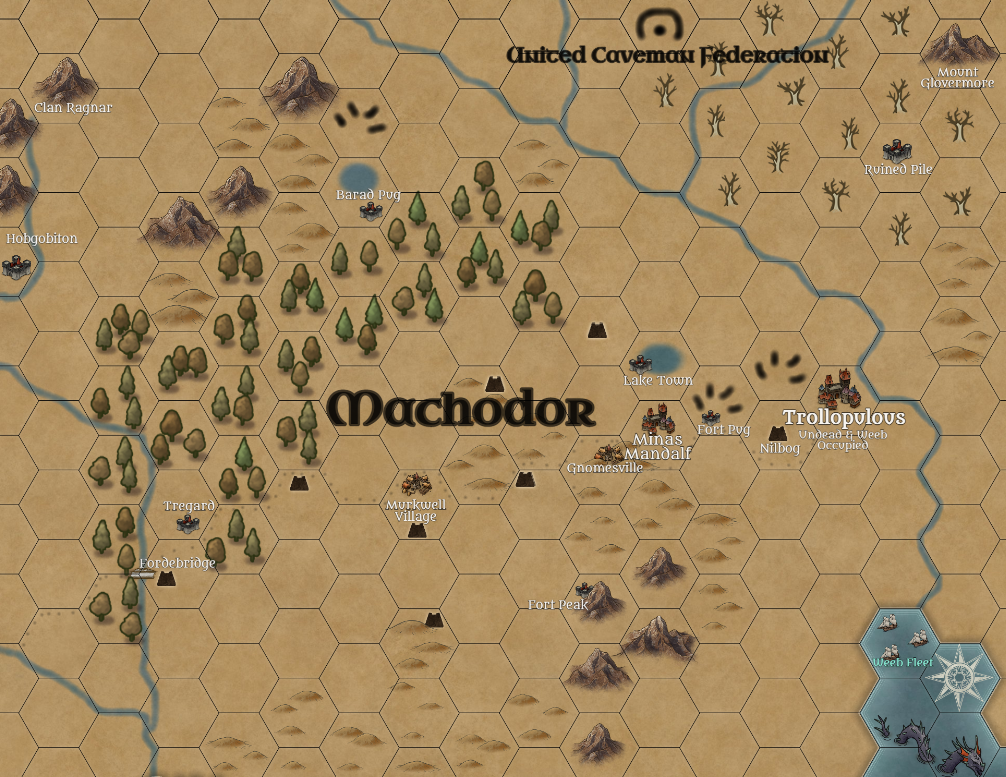 |
| The peace time flag of Machodor |
Jeffro asked me to write up how to do what I've been doing with my BROSR Trollopulous Campaign Patron domain, Machodor, since the end of his July 2021 game. So here we are in part one of a six part series. This entry starts with the assumption that a Patron character has acquired a stronghold, either by construction or conquest, in a suitable territory. The following rules then apply to growing that stronghold into a powerful domain;
"By patrolling the territory regularly — about once per week on a sweep basis, or daily forays to various parts of the area, the character will need only check once each week for incursions of wandering monsters (see APPENDIX C: RANDOM MONSTER ENCOUNTERS) on the Uninhabited/Wilderness table. Checks must also be made on the Inhabited table. If no road goes through the territory, then but one such check per week is necessary. If a road goes through, then three checks per week must be made on the Inhabited table."
...
"At such time as a territory has more than 30 miles of inhabited/patrolled land from center to border, then only the second type of monster checks are made, and all unfavorable ones, save one per month, are ignored. This reflects the development of civilization in the area and the shunning by monsters of the usual sort — things such as anhkheg might love it, however, and bandits may decide to make it a regular place of call. As usual, any monsters not driven off or slain will settle down to enjoy the place."
...
"In territories hacked from the wilderness, the “fame” of the owner will eventually spread so as to attract inhabitants to the safety (?) of the area. They will begin to appear after the player character’s stronghold is finished and patrols have generally cleared the area. The populace will match the area and the alignment of the character. When a random monster check reveals some form of creature who properly matches the potential inhabitant type for the territory, then have them move in and settle down, making proper subservience calls upon the master of the territory, naturally."
These Dungeon Master Guide quotes from pages 93-94 are the most important part of the domain rules in the 1e DMG. The instructions transform the relevant random encounter tables into domain building tables, and make the Monster Manual (and/or Fiend Folio) central to the task.
One thing that stands out from this is that a PC's alignment and race are very important for establishing the character of a domain. The implied setting of human dominance comes into play here with all the “men” encounters, and there are a lot of lawful good encounters too. The choice of alignment has a long term effect on the domain a character can build, so choose wisely (i.e. lawful good).
Note also the massive impact on encounter frequency that a road has. You will never look at roads the same way once you grasp this rule.
All of the above applies mainly for growing domains for Fighters, Clerics, and Magic Users in accordance with the class descriptions of their strongholds. The rules could also be applied to other classes but not directly in relation to their strongholds.
The real beauty of this system is that most of the load can be on the Patron players themselves, only a small subset of things absolutely require DM adjudication. And of course the DM still has a veto over his campaign.
Like many of the rules in the DMG, what is written has the feel of an illustration showing the application of wider principles to the situation described, which, once understood, also apply in other situations in similar but distinct ways. For example; what if I have a port instead of a road (or in addition to a road)? What about evil domains? What if my domain is spread across multiple caves in a large jungle?
It is not hard to imagine applying the principles to non-human cases, such as for demi-human cities, or even monster domains, but the actual rules would be case specific and worked out by the DM, possibly in conjunction with the Patron player.
In Part 2 I will discuss the rules for determining how the encounters translate into income for the domain, and in Part 3 how I applied the domain rules to Macho Mandalf in his city of Minas Mandalf and the wider Realm of Machodor.





What scale do you use with hexes?
ReplyDeleteWe are using 30 mile hexes. I originally thought this was too big, but they do have the advantage of providing plenty of scope for finding new things in already explored hexes. I'd probably prefer 24 mile hexes as this fits in better with horse and pegasus movement rates.
ReplyDeleteUse our tool Whois lookup to domain registration information like domain availability or the domain owner contact information. This may be useful if you need to contact the domain owner.
ReplyDelete